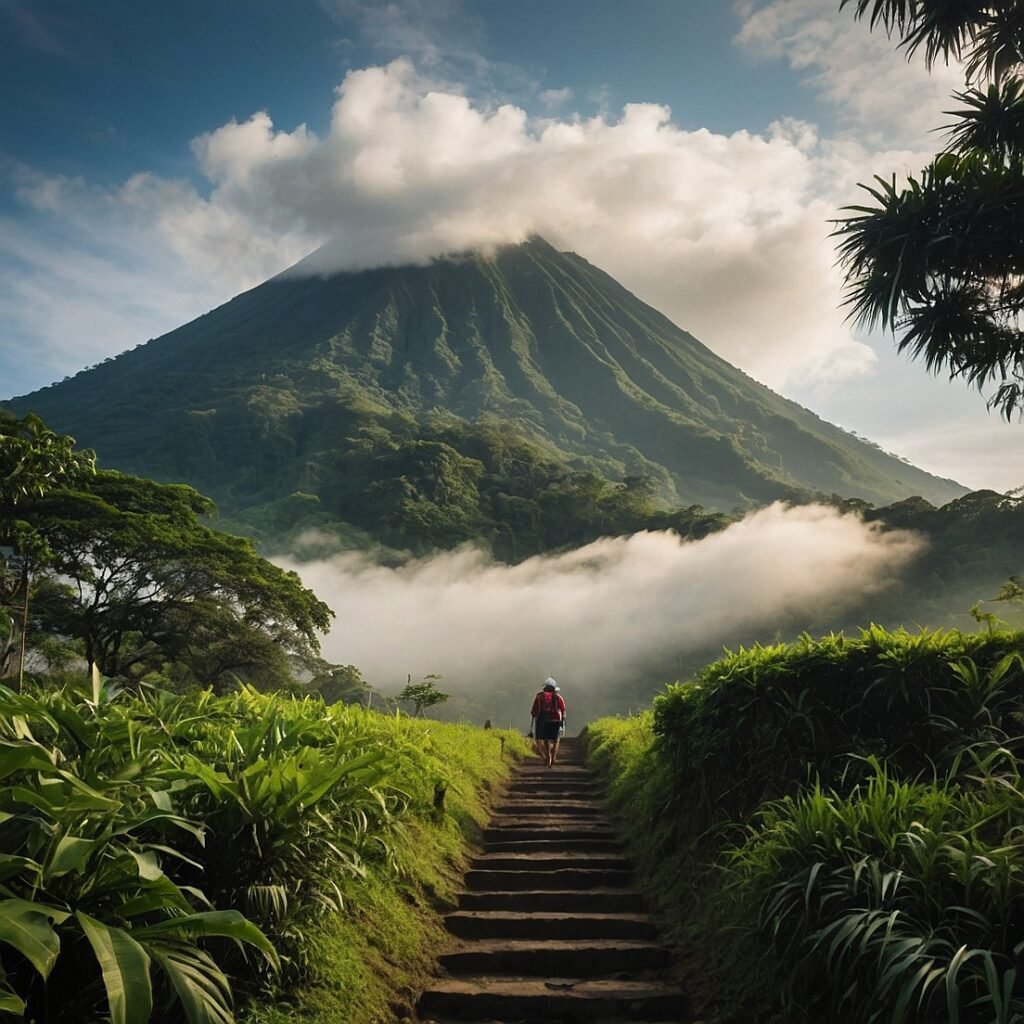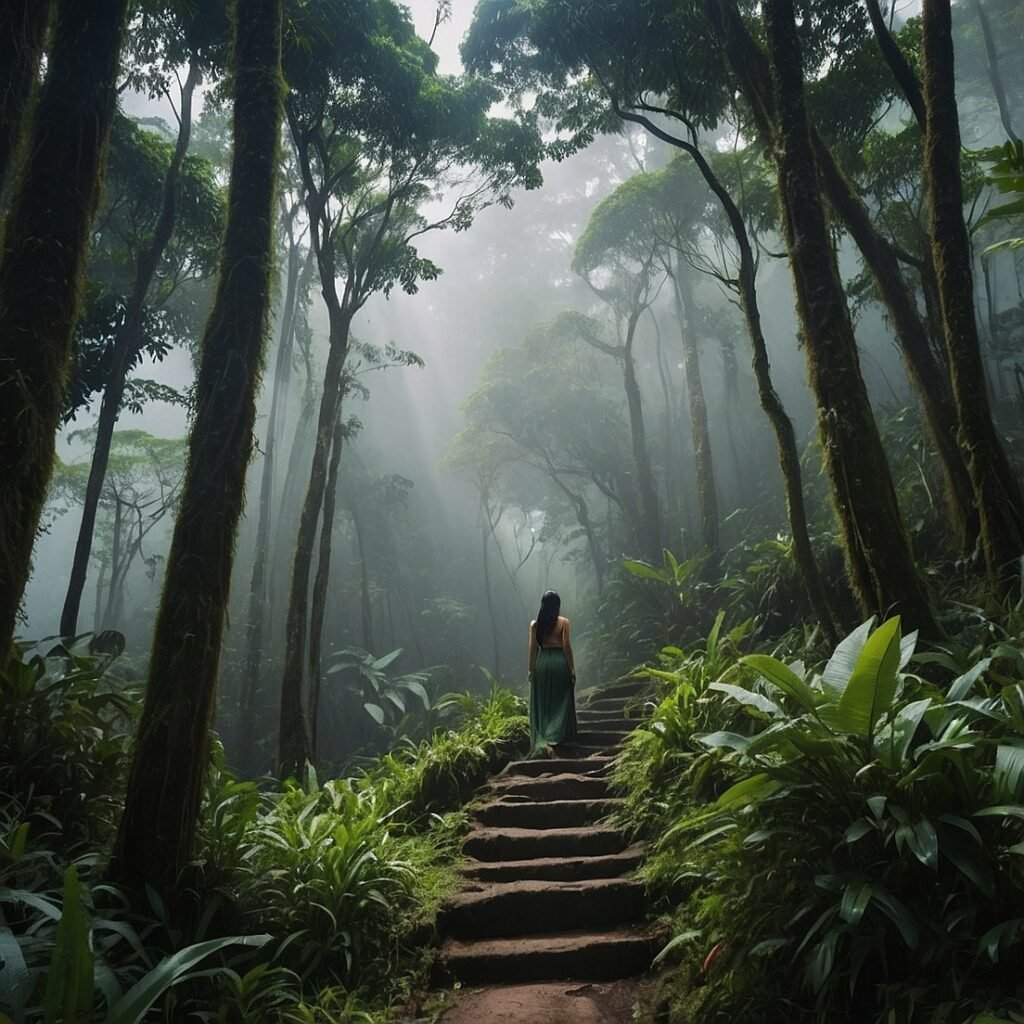Have you ever felt the inexplicable pull of a place, as if it were calling out to your very soul? Imagine standing at the foot of a majestic mountain, its peaks shrouded in mist, with the whispers of ancient spirits carried on the wind. This is the allure of Mount Banahaw, a sacred mountain that has captivated the hearts and minds of Filipinos for generations. As I embarked on my own pilgrimage to this mystical site, I found myself drawn into a world where the line between the physical and spiritual realms blurs, where faith and nature intertwine in a dance as old as time itself.
Mount Banahaw isn’t just any mountain. Rising proudly from the lush landscapes of Quezon Province, this dormant volcano stands as a silent sentinel, guarding centuries of spiritual traditions and natural wonders. It’s a place where the devout come to seek enlightenment, where nature enthusiasts marvel at its biodiversity, and where the curious come to unlock the secrets whispered by the mountain’s ancient stones. Join me as we explore the sacred slopes of Mount Banahaw, delving into its rich history, vibrant culture, and the profound impact it continues to have on those who answer its call.
The Majestic Guardian of Quezon Province
A Natural Wonder
Mount Banahaw is more than just a geographical feature; it’s a living, breathing entity that dominates the landscape of southern Luzon. Standing at an impressive 2,158 meters (7,080 feet) above sea level, this stratovolcano commands respect and awe from all who gaze upon it. Its slopes are a tapestry of dense forests, hidden caves, and crystalline streams, each playing a vital role in the mountain’s ecosystem and spiritual significance. The mountain’s unique microclimate creates a biodiversity hotspot, hosting a myriad of plant and animal species, some of which are found nowhere else in the world. As I hiked through its verdant trails, the air grew thick with the earthy scent of moss and the sweet perfume of wild orchids, reminding me of the raw power and beauty of nature.
A Volcano with a Gentle Soul
Despite its imposing presence, Mount Banahaw is considered a gentle giant. Classified as a potentially active volcano, it has been peacefully slumbering for centuries, with its last known eruption dating back to the prehistoric era. This long period of dormancy has allowed for the development of rich ecosystems and the establishment of human settlements around its base. However, the mountain’s volcanic nature is never far from the minds of those who live in its shadow. Geothermal activity still bubbles beneath the surface, manifesting in hot springs that dot the landscape – natural spas that are believed by many to possess healing properties.
The Spiritual Heart of the Philippines
A Pilgrimage Site for the Ages
For countless generations, Mount Banahaw has been revered as one of the most sacred sites in the Philippines. Its slopes are dotted with shrines, altars, and holy places that attract pilgrims from all walks of life. The mountain is often referred to as the “Holy Mountain” or “Mount of Salvation,” reflecting its deep spiritual significance. Pilgrims believe that climbing Mount Banahaw is a transformative experience, a physical journey that mirrors an inner spiritual ascent. As I made my way up the mountain, I couldn’t help but feel a sense of reverence, as if each step was bringing me closer to something greater than myself.
A Melting Pot of Beliefs
What makes Mount Banahaw truly unique is its ability to embrace a diverse array of spiritual beliefs. While it holds special significance for Catholics, who make up the majority of the Philippine population, the mountain is also sacred to followers of indigenous Filipino spirituality and various New Age movements. This spiritual syncretism is evident in the eclectic mix of religious symbols and practices you’ll encounter on the mountain. In one area, you might find a Christian cross standing next to an ancient boulder believed to possess mystical powers. It’s this harmonious coexistence of different faiths that gives Mount Banahaw its distinctive spiritual energy.
The Path of the Pilgrim
Preparing for the Journey
Embarking on a pilgrimage to Mount Banahaw is not a decision to be taken lightly. The mountain demands respect and preparation from those who wish to explore its sacred sites. Before setting out, I made sure to research the proper protocols and pack appropriately. Here’s a quick guide for those considering their own pilgrimage:
| Essentials | Recommended | Prohibited |
|---|---|---|
| Water and snacks | Comfortable hiking shoes | Alcohol |
| First aid kit | Light, modest clothing | Loud music players |
| Flashlight | Walking stick | Revealing attire |
| Eco-friendly bags | Offering items (candles, flowers) | Littering |
It’s important to note that some areas of the mountain are closed to visitors during certain times of the year to allow for ecological recovery. Always check with local authorities for the most up-to-date information on access and restrictions.
The Sacred Trail
As I began my ascent, I quickly realized that the journey up Mount Banahaw is as much a spiritual experience as it is a physical challenge. The trail is dotted with stations, each representing a different aspect of the pilgrim’s spiritual journey. One of the most famous sites is the “Kalbaryo” or Calvary, where pilgrims reenact Christ’s passion by carrying heavy wooden crosses. The path also leads to numerous caves, each with its own legend and spiritual significance. One such cave, known as “Kuweba ng Dios Ama” (Cave of God the Father), is said to be a place where one can communicate directly with the divine.
Unveiling the Mountain’s Mysteries
Legends and Lore
Mount Banahaw is steeped in folklore, with stories passed down through generations adding to its mystical allure. One of the most intriguing legends speaks of the mountain as the new home of God, replacing Mount Sinai of biblical fame. Another tale tells of a hidden paradise within the mountain, accessible only to those pure of heart. As I listened to these stories shared by fellow pilgrims and local guides, I found myself captivated by the rich tapestry of beliefs woven into the very fabric of the mountain.
The Power of Belief
Whether you’re a devout believer or a curious skeptic, there’s no denying the profound impact Mount Banahaw has on those who visit. Many pilgrims report experiencing visions, hearing mysterious voices, or feeling an overwhelming sense of peace and connection to the divine. While these experiences can be attributed to the power of suggestion or the mountain’s unique atmosphere, they underscore the deep spiritual significance of this place. As I stood atop one of the mountain’s peaks, gazing out at the sweeping vistas below, I couldn’t help but feel a sense of something greater than myself, a connection to the natural world and the generations of pilgrims who had stood in this very spot before me.
Guardians of the Sacred Mountain
The Protectors of Tradition
Mount Banahaw isn’t just protected by its natural defenses; it’s also guarded by dedicated individuals and communities who have made it their life’s mission to preserve the mountain’s sanctity. Local spiritual leaders, known as “Mga Tagapag-alaga” (Caretakers), play a crucial role in maintaining the sacred sites and guiding pilgrims on their spiritual journeys. These guardians of tradition are repositories of ancient knowledge, keeping alive the rituals and practices that have been passed down through generations. During my visit, I had the privilege of speaking with one of these caretakers, whose eyes sparkled with wisdom as he shared stories of the mountain’s secrets and the importance of respecting its sacred nature.
Environmental Stewardship
The spiritual significance of Mount Banahaw is inextricably linked to its natural beauty and ecological importance. Recognizing this, many local communities and organizations have taken up the mantle of environmental stewardship. Efforts to protect the mountain’s biodiversity, maintain its forests, and educate visitors about sustainable practices are ongoing. As I hiked through the mountain’s trails, I was heartened to see signs encouraging responsible tourism and volunteers engaged in cleanup activities. It’s a powerful reminder that preserving sacred spaces often goes hand in hand with preserving the natural world.
The Healing Powers of Banahaw
Nature’s Pharmacy
Mount Banahaw isn’t just a spiritual powerhouse; it’s also renowned for its healing properties. The mountain’s slopes are home to a vast array of medicinal plants, many of which have been used in traditional Filipino medicine for centuries. From herbs that soothe stomach ailments to leaves that can help reduce fever, the mountain is a veritable natural pharmacy. Local healers, known as “albularyo,” still practice their craft using these plants, offering an alternative to modern medicine that is deeply rooted in the mountain’s lore.
The Therapeutic Touch of Nature
Beyond its herbal remedies, Mount Banahaw offers healing in a more holistic sense. The simple act of immersing oneself in nature, breathing in the clean mountain air, and disconnecting from the stresses of modern life can have profound effects on one’s physical and mental well-being. Many visitors report feeling rejuvenated and centered after spending time on the mountain, even if they don’t engage in specific spiritual practices. As I sat by one of the mountain’s pristine streams, listening to the soothing sound of water cascading over rocks, I felt a sense of peace wash over me, a healing balm for the soul that no prescription could provide.
Challenges and Conservation
Balancing Spirituality and Sustainability
The increasing popularity of Mount Banahaw as a pilgrimage site and tourist destination has brought with it significant challenges. The delicate ecosystems of the mountain are under pressure from human activity, with issues such as trail erosion, litter, and habitat disturbance becoming growing concerns. Balancing the spiritual and cultural significance of the mountain with the need for environmental conservation is an ongoing struggle. Local authorities and environmental groups are working tirelessly to implement sustainable tourism practices and educate visitors about the importance of preserving this sacred space for future generations.
The Future of Mount Banahaw
As we look to the future, the fate of Mount Banahaw hangs in the balance. Will it continue to be a beacon of spirituality and natural wonder, or will the pressures of modern life and unchecked tourism take their toll? The answer lies in the hands of those who love and respect the mountain – from local communities and government officials to pilgrims and nature enthusiasts. By working together to implement responsible practices and fostering a deep appreciation for the mountain’s cultural and ecological significance, we can ensure that Mount Banahaw remains a sacred haven for generations to come.
A Call to the Spirit
As my journey on Mount Banahaw came to an end, I found myself forever changed by the experience. The mountain had worked its magic, leaving me with a profound sense of connection to something greater than myself – be it nature, spirituality, or the collective human experience. Mount Banahaw stands as a testament to the enduring power of faith and the awe-inspiring beauty of the natural world. It reminds us that in a world increasingly dominated by technology and urban sprawl, there are still places where the veil between the physical and spiritual realms grows thin.
For those seeking a deeper connection to their faith, a transformative natural experience, or simply a moment of peace in a chaotic world, Mount Banahaw beckons. Its slopes hold secrets waiting to be discovered, its streams whisper ancient wisdom, and its peaks offer a glimpse of the divine. Whether you’re a devout pilgrim or a curious traveler, I encourage you to answer the call of this sacred mountain. Walk its hallowed trails, breathe in its pure air, and open your heart to the mysteries it holds. Who knows? You might just find that piece of yourself you never knew was missing.
Disclaimer: This article is based on information available up to 2016. While every effort has been made to ensure accuracy, please note that conditions, access, and regulations regarding Mount Banahaw may have changed since then. We encourage readers to verify current information with local authorities before planning a visit. If you notice any inaccuracies in this article, please report them so we can correct them promptly.




